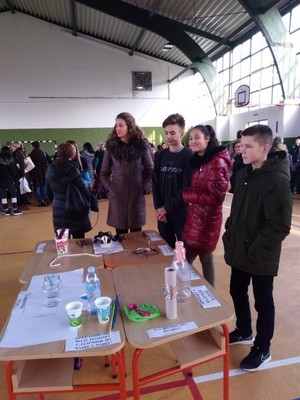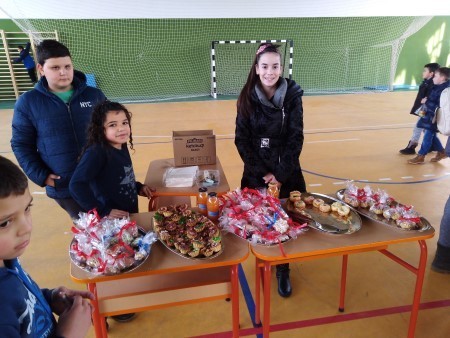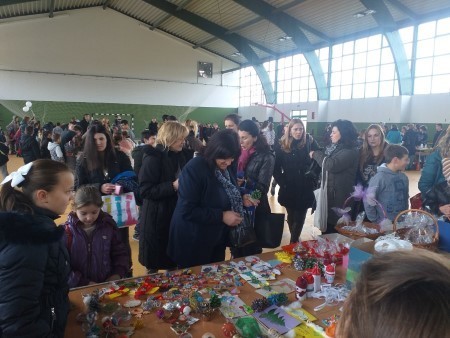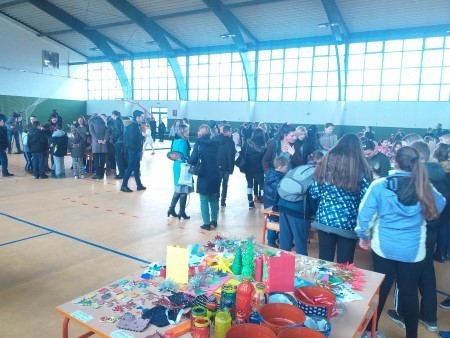OŠ "ĐURO ESTER" KOPRIVNICA - CROATIA
Excellent second place on European competition.docx
Sedmašice osvojile izvrsno drugo mjesto na europskom natječaju.docx
Seventh-graders win an excellent second place in the European competition My EuroVision
The seventh-graders at Primary School “Đuro Ester” Koprivnica, Hana Bijelić, Hana Pelesk, Lucija Turk and Lorena Miklošić, participated in My EuroVision competition and won an excellent second place with kamishibai story „The Truth“. The students speak about their experience with this specific storytelling technique and reveal what the path from an idea to success and the prize was like.
What is kamishibai and where does it come from?
Hana B.: Kamishibai is the art of storytelling with the help of illustrated cards on a miniature wooden stage. It originates from Japan. The name kamishibai is derived from two words: kami, meaning paper and shibai, meaning play or theatre. At the beginning of the 20th century Japanese storytellers travelled by bicycle from village to village (gaito). They were selling handmade sweets. Besides sweets, Kamishibai men would secure a small wooden box to the back of their bicycle. When they banged their wooden clappers, children would gather round the storyteller, buy sweets and listen to kamishibai. It was a nice reward for their purchase. Kamishibai consists of hyoshigi (wooden clappers that storytellers use to announce their presence and the beginning of their story; we did not use them, though) and butai (a small wooden/cardboard box) where illustrated cards are placed. The format of the paper for illustrations is not important as long as it fits the box (butai), and likovna tehnika je također izborna. Kamishibai is a useful tool to use with children to stimulate their imagination, creativity, artistic expression and language use.
Have you heard about kamishibai before this project and in what sense?
Hana P.: I have heard about visual storytelling, but I have not heard about kamishibai.
Hana B., Lucija T., Lorena M.: We did not hear about kamishibai before this project.
We have read that your story was written after the workshop with the French artist Jessica Gobert. Tell us what this workshop was about.
Hana B.: In the workshop with the French artist Jessica Gobert we were introduced to kamishibai. The workshop was held online via Zoom. Ms Gobert helped us adapt the story for storytelling and she told us what to correct, improve and change. The workshop lasted for 4 hours in total, but our class teacher organised it in two parts to make it easier for us as we needed a break after two and a half hours. The remaining hour and a half of the workshop was done the next day.
Hana P.: I am glad that we met Jessica Gobert who helped us with our story and it was fun to communicate with her in English. As Hana has already said, the workshop lasted for four hours via Zoom platform. However, our work on the project lasted much longer.
Lucija T.: Jessica helped us make a kamishibai frame and develop our story... The workshop was in English so we had to test our knowledge of English, which was exciting. It was also interesting to work via Zoom because it was a new experience to us.
Lorena M.: After assembling the frame, we started drawing and illustrating the story. We had to adapt and shorten the story as well as translate it into English. Finally, we practised the storytelling for filming.

Workshop with French artist on zoom
We have found out that the text for the story „The Truth“ was written by our student Hana Pelesk, so we would like to know where the author got the idea for this topic?
Hana P.: Our Croatian homework task was to write a composition with elements of science fiction. It was at the time when everyone was surprised by the novel coronavirus pandemic. I was a little bit scared and nervous because I did not know what would happen, so, in the midst of lockdown and isolation, I got the idea for the topic of this story. The idea of people enclosed in capsules was born then. I myself was unhappy because we were at home all the time and I simply missed the world outside, the nature. The message behind this story is that people cannot live without nature. They need it. Nature provides everything we need to survive, but we do not reciprocate, but exploit and destroy it. This story aims to remind the readers that we need to appreciate nature, take care of it and clean up the mess we have made. Nature is all we have.
What material is needed to make the props for kamishibai storytelling technique and who was involved in making the props for your story?
Lucija T.: The frame was made of cardboard and we used a slightly thicker paper for the drawings. The four of us made all the props with the help of our classmates. We are grateful to our mentor and class teacher Martina Trešćec Godek, who inspired us to take interest in kamishibai and who guided us through the whole process. We would also like to thank our music teacher Mihael Kivač, who helped us with technology.
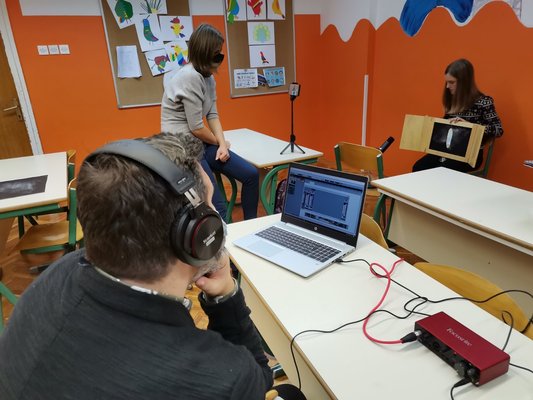
Tell us about the process of making your kamishibai from text to performance.
Hana B.: First we had to find the material needed for making the frame: cardboard, pencils, scissors, ruler, brushes, etc.
Hana P.: First we designed the frame with the help of our class teacher and Ms Jessica Gobert and then we drew the story “The Truth”.
Lucija T.: We decorated the frame that we used for our drawings. Then we adapted the story and translated it into English. The story was titled The Truth.
Lorena M.: Hana Bijelić told the story in English. Our class teacher filmed her storytelling and our music teacher helped us with the soundtrack. Our video was submitted for the competition and we hoped for the best possible result in the category for primary school students (7th and 8th grades), secondary school students and university students from EU countries.
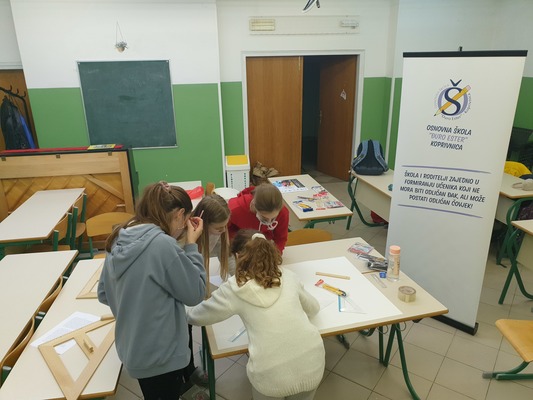
Which part of the project did you find the most fun and which was the most demanding?
Hana B.: Although I liked everything, the fun part to me was drawing and decorating the frame and the most demanding part was the storytelling.
Hana P.: Apart from drawing, the most fun part to me was writing the story, although at that time I was not aware that a kamishibai story and audio drama would be based on it. Drawing was the most demanding part because it took a lot of effort and time
Lucija T.: The workshops were the most fun part and drawing was the most demanding part to me.
Lorena M.: The design of the frame was the most fun part and I agree that drawing was the most challenging part.
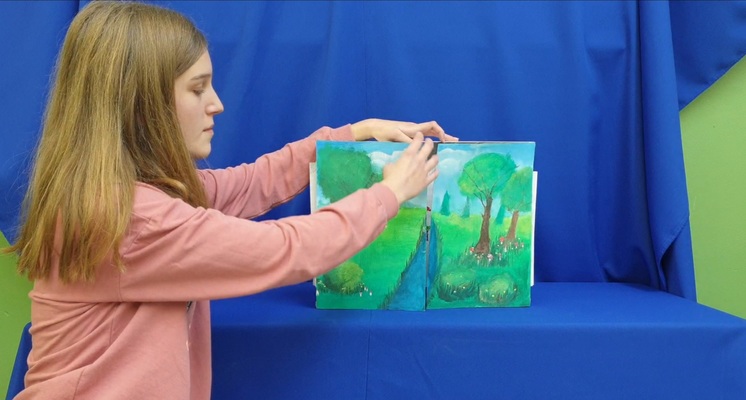
What was your kamishibai praised for and did you expect such success in this competition?
Lorena M.: We were only informed that our kamishibai won an excellent second place. Our mentor was full of praise for our drawings during the workshop. 😊 I did not expect anything and I am really pleased with the result.
Hana B.: I did not expect anything. I had fun and that was the only important thing to me :). I am pleased with the result!
Hana P.: I did not even think about the result. Actually, the most important thing to me was to finish our kamishibai.
Lucija T.: We did not even have time to think about the result because we were focused on finishing our kamishibai all the time, but the result is great.
What would you change in the organisation of this competition?
Hana B., Hana P., Lucija T., Lorena M.: The workshop was a wonderful experience to us and we would not change anything.
Have you had a chance to see kamishibai made by the students from other European countries who participated in the competition?
Hana B., Hana P., Lucija T., Lorena M.: Not yet, but we would love to see the work of other students, especially kamishibai that won the first prize.
You have all won sports and action video cameras. What will you use them for?
Hana B.: For my new hobby – photography and filming :)
Hana P.: For experiments with photography and filming.
Lucija T.: At weekends my family and I love going on biking trips so I will use it to capture those moments with my new camera.
Lorena M.: For travel photography.
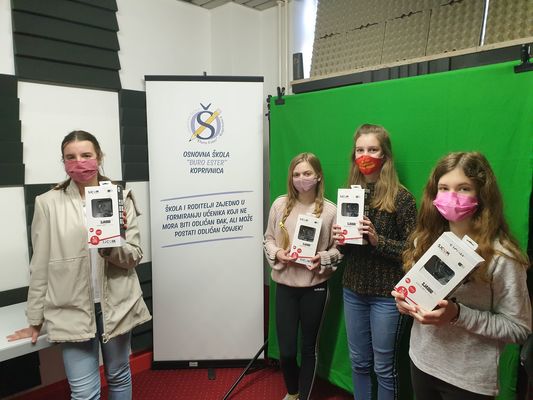
Do you plan to participate in a similar project?
Hana B.: Yes, maybe in the near future.
Hana P.: Of course, I love these kinds of projects.
Lucija T.: If I get a chance to participate in such wonderful project, I would gladly agree.
Lorena M.: Of course, if I get a chance.
What is your opinion of kamishibai as a storytelling technique and how could it be used at schools?
Hana B.: Honestly, at first I thought that kamishibai was nothing special, but after we finished all the work, the frame, drawings and retelling itself, it exceeded my expectations. At schools this technique could be used as a learning tool for illustrating lessons in order to help some students understand them better. I think that most of us prefer the visual learning style.
Hana P.: I think it is a very useful technique because looking at drawings and listening to the story can help us understand the story and its message better. Kamishibai could be used for school reading and similar things.
Lucija T.: I liked kamishibai technique right from the start and I was excited to be involved in this project. I think kamishibai is a great technique for younger students because school reading could be made more interesting and fun.
Lorena M.: I would definitely recommend the use of kamishibai at schools because it increases imagination and creativity and it can also be fun and educational.
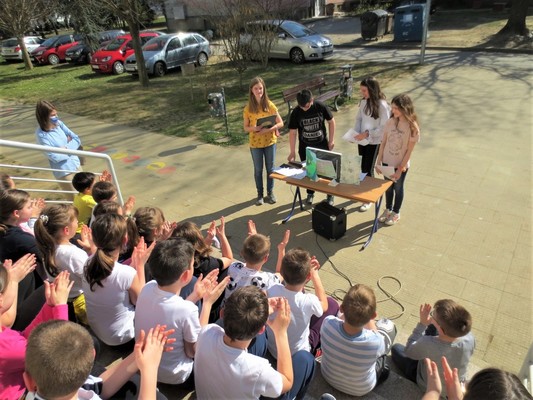
What did you learn from this project?
Hana B.: I learned that collaboration can lead to a great result. I also learned that we can be creative in many different ways.
Hana P.: I learned something new about Japanese culture and teamwork – working in a team is more fun.
Lucija T.: I learned that teamwork can lead not only to a great result but also true friendship. I also learned about kamishibai technique and this form of art.
Lorena M.: When we collaborate, anything is possible.
How will you use the knowledge and experience that you have gained?
Hana B.: In some other competitions perhaps, but also in life in general.
Hana P.: I will appreciate and enjoy teamwork more.
Lucija T.: I think that the experience we have gained can be useful in many areas of life.
Lorena M.: Perhaps in some future competitions.
In the end please share an experience, a feeling or a thought about this project in one sentence.
Hana B.: Happiness and excitement, but also little nervousness during storytelling. It was a nice experience.
Hana P.: I got to know my collaborators better 😀 and I was proud of us because we managed to present the story to the listeners and viewers in a new way. We also learned a bit about Japanese culture. It was hard work, but we also had fun!
Lucija T.: I think that this project was a wonderful experience and I was honoured to be a part of the team.
Lorena M.: A wonderful learning experience.
You can also read about the participation of our students in My EuroVision competition on our school website via link Osnovna škola "Đuro Ester" Koprivnica - Naslovnica - Učenice 7.c sudjelovale na natječaju “My EuroVision“ (skole.hr)
Questions written by: Mirta Jurić, 6.c
School Newspaper Group
Primary school „Đuro Ester“ Koprivnica
Scoala Gimnaziala ,,Mihai Eminescu” Alexandria - Romania
MY PASSION.docx
MY PASSION
My name is Gănescu Alexia Maria. I am an 8th grade student at the "Mihai Eminescu" Gymnasium School in Alexandria. I am honored to write an article for our school newspaper. I really enjoy reading and writing, so I decided to I create a blog where I can share my passion and try to make other people love reading.At the beginning of the summer vacation, when I received the merit scholarship, I managed to buy a field and started working there. It took me a while to get used to all the programs and functions that those applications offer me, but I also had fun learning all this.
My first review is of the book "Miracle" written by RJ Palacio, a very well structured book, with an impressive lesson about the acceptance of people with disabilities, which is worth reading by anyone. Along the way, I started writing interviews with contemporary Romanian authors. I have also posted articles for students, with theory for the Romanian language, from what I have studied at school so far. something and I found it an interesting idea and, at the same time, a challenge for me.
Currently, I have posted about 40 articles, which I have worked on wholeheartedly and I am very happy when I see people who appreciate my work. You can find me on Google by typing: www.alexiabooks.ro
Here you will find reviews for books of all kinds.
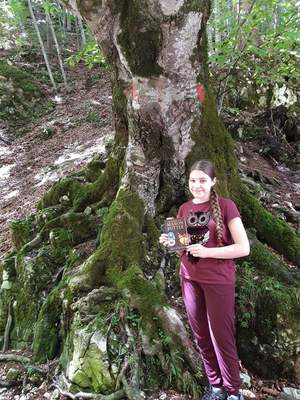
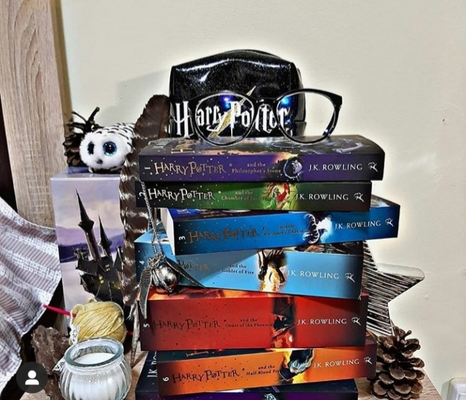
I mention that it is not easy to maintain such a page, to be active, to choose your words, not to reveal something essential from the book you are reviewing, to keep in touch with the followers, etc.
Shortly after creating the blog, I created an Instagram account, thus entering the bookstagram community, where I met special people and made good friends. On Instagram, my name is @alexiabooks_. Here I keep my followers up to date with everything I read and what books appear in my library. I regularly organize giveaways, during which participants can win nice prizes. I post artistic pictures of the books I read and make recommendations to those who ask me to. Through Instagram, I managed to get some collaborations with their authors or agents, who sent me free books to review. I am very happy because my blog has registered 1000 visitors and I thank those who are already following my activity there and you helped me get to this point. During school I post an article a week, and during the holidays two or even three a week.
Also, on the Instagram page, but also on the blog, you will find links that, if you access them, you can benefit from the best offers for books and more.
Out of a desire to improve my knowledge, I started reading in English and I will create a special category for reviews of these books, because I know that many people read in foreign languages, especially English and I want to be on my page something for everyone.
Thank you for reading the short story of my blog, and if you need a book recommendation or to get to know us better, you can contact me on my Instagram page I mentioned above.
Author : Alexia Gănescu, 8 A; photo Alexia Gănescu
IC BERTOLOTTI - GAVARDO - ITALY
MEDIA LITERACY.pdf
MEDIA LITERACY

Every day there is a new technology in our lives, and that introduces new rules and possibilities for our daily routine in the media. One of the most important ones is privacy, which includes your personal information, as your passwords, your family names, your location, etc. It is really important that the parents supervise their children on social media and the internet, because almost everywhere you navigate on the internet there is always *scammers. The parents are responsible for their family security and privacy information.

*person who commits or participates in a fraudulent scheme or operation credit card scammers. The company will not call you to ask for your Social Security or account number, but nefarious scammers might.
With social media, there comes loads of rules and regulations, here are the most important ones:
- Don’t feed the trolls
An Internet troll is someone who makes intentionally inflammatory, rude, or upsetting statements online to elicit strong emotional responses in people or to steer the conversation off-topic. How should you speak to trolls? Don’t! Just ignore them. Many people take the bait and start hot debates trying to explain their point of view and spend a great deal of time and effort in vain.

- Think of readers’ reactions
You should consider carefully what you post on pages of other people and of public-facing accounts such as corporations or universities. For example, in 2013 a man from Pennsylvania was fired for “complimenting” a female student online. His comment was neither sexual nor inappropriate, but evidently, the girl’s mother did not like it.
- Don’t make your private data public
Many social networks offer to “check in” the location of where you took a photo or posted something, or display the places you have visited. By default anybody can access that data, and criminals have a thousand and one methods to use it, from breaking into your house to stealing your digital identity. That’s why you should hide this kind of data from strangers, it is also a good reason not to add to your friend list indiscriminately: the people sending requests to connect with you can be bots, trolls, or even criminals.
WEB REPUTATION OR ONLINE REPUTATION

With social media there comes, a view, from the person, company, teacher etc… that's why it is important to be very careful with you “online reputation”:
An online reputation, or e-reputation, is the reputation of a company, person, product, service or any other element on the Internet and digital platforms.
This online reputation is impacted by the content an organisation distributes, the reactions of and interactions with web users, activity on social networks, etc.
For e-commerce brands, online reputation is very important, as it can affect their online store’s credibility and visibility.
Be careful online and stay alert!
Authors:Leonardo A.T. and Arianna M.
https://www.kaspersky.com/blog/social-networking-rules/12590/
https://www.atinternet.com/en/glossary/online-reputation/#:~:text=An%20online%20reputation%2C%20or%20e,activity%20on%20social%20networks%2C%20etc.
OŠ Sveti Petar Orehovec - Croatia
Video games.docx
Videoigre.docx
Almost a thousand kuna ‘taken’ from parents’ account for kid’s video game
Here is the catch – our questioner showed that more than half the parents of the questioned students don’t have any rules regarding playing video games
It is not unusual to see sleepy students during the lessons. That can happen to anyone from time to time, but it usually happens to those who play video games deep into the night or even till the morning. Yes, we are not wrong. You read it right, there are students who told us that they have played video games well past midnight or even until 3 or 4 in the morning on the school days when they have classes in the morning shift from 8 o’clock.
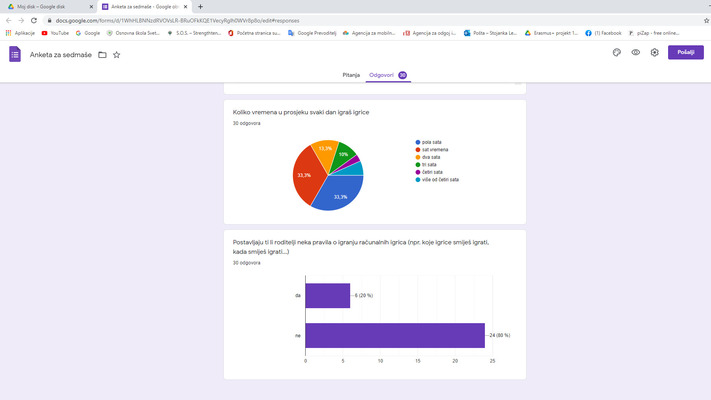
There are also some students who spend a lot of money on games. That is not too big of a problem if their parents are aware of that, but a few days ago we found out that one of our students has spent almost a thousand kuna (about 130 €) from his parents’ without them knowing any of that. Without thinking too much, he clicked that he wants to buy something for the videogame he played and in just a couple of seconds the money was gone. Examples like this one were our motivation to dedicate our MAIN TOPIC to the habits of the students in playing videogames, and that is why we have conducted a survey among our students to get a glimpse into their habits.
Results showed the following; among 146 students who took part in the survey, 146 of them (81, 7%) mostly play games on their smartphones. We have also found out what percentage of parents have set some rules for their children regarding videogames. We think that the catch why our students yawn during the lessons is right here, in the lack of rules set by parents about playing video games.

We came to that conclusion because a bit more than half of our students (53%) said that they don’t have any rules set by their parents regarding video games. Most students from 4th grade have some rules set by the parents. From 17 fourth-graders, 12 of them (70%) have some sort of rules regarding videogames. Students from 7th grades have the least rules set by their parents. From 24 surveyed seventh-graders, 80% of them said that they don’t have any rules regarding video games. /Lara Trušček, 6B/
OŠ "Dositej Obradović" Ćićevac - Serbia
Living Library.docx
Living Library

Last weekend, children and adults in Ćićevac were able to use a unique opportunity to talk to books. The "Living Library" project was presented in our city, and a blind girl, a military invalid, a member of the Serbian national team in wheelchair basketball and a protector of animal rights - books in it - delighted their readers.
A large number of our fellow citizens joined the living library and enjoyed a half-hour conversation with the book he chose at the entrance to the library. Some of them read several books, because they couldn't decide on one, just like in a real library!
In a conversation with one of the books, we learned that Serbia has 80 registered wheelchair basketball players, that the most important thing is to fight and not give up on quality of life, and that everything is possible, even to fight with your own psyche, when you become disabled, circumstances. The young representative of Serbia in basketball is full of life energy, smiling and cheerful and will remain in our memory for a long time.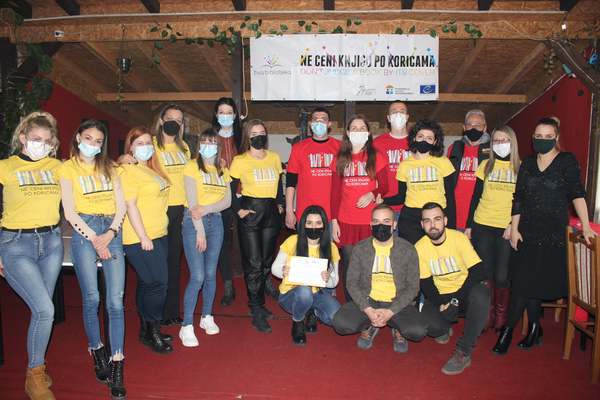
After Ćićevac, the Living Library continues to be realized in other cities in Serbia.
The Living Library in Ćićevac was realized in cooperation with the association "Okular" with the association "Hajde da…" from Belgrade and the "Youth Initiative for Human Rights" from Bosnia and Herzegovina, through the joint regional program of the United Nations "Dialogue for the Future". /Sanja Ivanović/
OŠ Marije Jurić Zagorke Zagreb - Croatia
New singing star.docx
Nova pjevačka zvijezda.docx
New singing star in Dubrava
Messy hairy dog King shows great musical talent
In Dubrava, Zagreb, the Kobasić family have a playful dog of the Japanese breed Shiba Inu. Hiss twelve year old owner Vito discovered his singing abilities completely by accident. Two weeks ago, while Vito was practicing piano, the happy King enjoyed it and kept wagging his tail. One day, Vito played the Periplaja, a dance from Dalmatia, composed by Ivan Lhotka Kalinski. King immediately got up, put his head high and joined Vito with his howling. He howled like an opera singer and danced on all fours like he was doing Michael Jackson's moonwalk.

Unfortunately, Joža, the family’s neighbour had no understanding for the noise, so he loudly knocked on the Kobasić door. When he saw King's dance moves and the passion Vito was playing with, he immediately stopped complaining.
Ms. Kobasić rewarded King with a piece of smoked sausage and she asked the neighbour over for rakija. Dona, a german shepherd from a nearby yard, also ejoys King's singing – she sends him love signals. 
Vito and King keep practicing their new composition, tricks and choreography for Croatia's first Pet talent show, which will take place in May od 2021 in accordance with the Covid-19 regulations. /Vito Kobasić/
Scoala Gimnazială Nr. 6 Suceava, Romania
FINAL.docx
CLIMATE ACTION PROJECT
The students from the Gymnasium School Nr. 6 Suceava involved in the CLIMATE ACTION PROJECT.
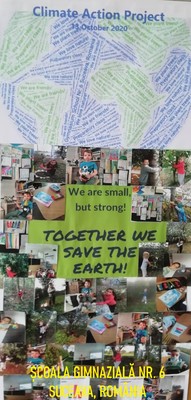
The Climate Action project was launched in 2017 with the aim of connecting students globally and enabling them to discuss, create and share results and solutions online. As participants in the project, teachers and students exchange experience and local information, thus making learning global, but also authentic. In previous years, students have devised solutions and taken action at the local level, while contributing to a truly global conversation and reviving the cry for the importance of action on climate change.
The main goal is to educate global citizens who have a deep and nuanced understanding of the world in which they live and who are willing to take action for a better world. People who are creative, empathetic, collaborative, and who love problem solving. What students see in the future ... and the right teachers!
,, I am glad that Mrs. Roibu teacher Daniela Florentina encouraged me to participate in the Climate Action Project.
It's great that young people on 6 continents can connect virtually and try to find solutions to one of the world's most pressing challenges: Climate change!
If we all join forces, the mentalities of society regarding this world problem will be changed and the Earth will be saved! ”
(Gherman Antonia, V-A)
"Our mission is very important! The climate of our planet changes from year to year, causing the melting of the icebergs in the North Pole.
The "global warming monster" has woken up! Not a good sign at all !!!! ”
(Andreica Maria, V-A)
"Now I feel that we have begun to realize the true value of nature. Destroying our planet costs us a lot of money.
It's about saving our planet. "What can we do to save it?"
(Bolohan Gabriela, V-A)
The students of the Gymnasium School Nr. 6 Suceava / Romania are delighted to participate in this global project.
Climate change, the "Global Warming Monster" is causing real disasters.
Analyzing this issue together with all students, it was concluded that humans are responsible for the fate of planet Earth.
Everything is in people's minds and wills!
Thus, several solutions have been found, which are applied to save Planet Earth:
1) Development of centers of expertise in the field of CLIMATE CHANGE;
2) Studying a discipline in schools to make students aware of the dangers that await us if we do not take action in this regard;
3) Aggressive media campaigns.
Simioniuc Rareș, V-A
https://drive.google.com/file/d/1bShE2scyu9r8lB_FTi3Fmd1FK_EWTFbJ/view?ts=5f8a91fb
OŠ ,, IVO ANDRIĆ'' PRANJANI -SERBIA
Novogodišnja naučna čarolija.docx
New Year's science magic.docx
New Year's science magic
This event is being organized in our school for the second time. All students and teachers of our school have a part in it. Visitors are students, teachers and locals. This event, which takes place throughout the day, begins with decorating Christmas trees with recycled decorations. All departments compete, and the winner receives a prize. The event continues in the school hall, where experiments in physics, chemistry, biology, technical and engineering are performed on the stands. They are performed by students with the help of their teachers. There is also a sales area, where you can buy various products such as decorative items, decorations for Christmas trees, greeting cards, picture frames, jam, juices and many other interesting things. The money from the sale goes to charity.
Such manifestations are useful because we learn many more things that we cannot do during regular classes. It shows us that science is interesting, to try different experiments, make different objects and to give the money we earn from it to someone who needs it for treatment.
I hope that this event will become a tradition and that it will be organized every year, to socialize, learn and acquire new knowledge.
You can read more about the event on the school board.
https://www.skola-pranjani.com/index.php/2014-03-02-15-57-14/2014-03-02-21-11-01/588-drug-nif-s-ci-n-v-g-disnj-n-ucn-c-r-li
Nemanja Babović-5.razred.

